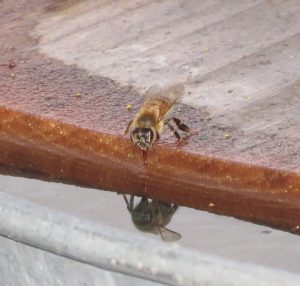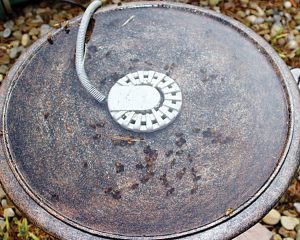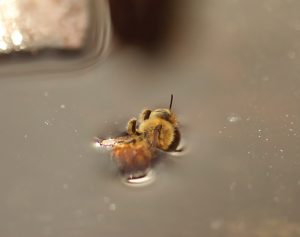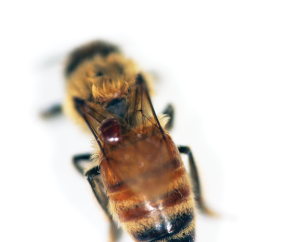 Hang on – this is not just another how to water-your-colony article.
Hang on – this is not just another how to water-your-colony article.
By: James Tew
Bees need water – I get it. What else have you got?
Bees and their warm weather water needs have been the subject of numerous articles that many others and I have written in recent years. Primarily, my pieces centered on the concerns that my near neighbors had about water foragers at birdbaths and how the bees were keeping the birds away. At times, swimming pools were involved in the complaints.
Initially, I defended the bees to my neighbors, but over time and after viewing many water-foraging episodes, I was forced to admit that my bees were keeping birds from watering at my neighbor’s device. At any given time during the warm day, there could be hundreds up to a few thousand bees gathering water.
Just for a quick review of these past articles, I put out my own watering devices. I never let them run dry. I asked you what you were using for watering devices. You responded with many interesting suggestions. In general, a good discussion was had during the following months and the topic seemed finished. Indeed, my neighbor finally just gave me the birdbath that my bees loved so much, and she got a new one. All of you who have kept bees for a few years know how that aspect of the story ended. Regardless, that part of the bee water story is not what interests me right now. This water-need subject seems to have a lot of unanswered questions. Maybe written more appropriately – this water-need subject seems to have many questions that have never been asked.
Why do bees collect water?
The current best concept is that a colony needs water for honey dilution for brood feeding, for cooling the hive, and for individual bees that are thirsty. As far as this traditional information goes, I agree. But over the past few years, it would appear that there is more to this water question that has been addressed.
They show up abruptly at the watering device
As I write, it is mid-November. On typical days, gentle wind, partly cloudy, at 42-44°F, foragers suddenly begin showing up at the watering source. There is precious little brood in my colony. I can’t imagine any water is needed for brood? The hive that houses the colony is certainly not overheated. There is no obvious reason for cooling the hive. Are these just individual thirsty foragers? What about all the nurse bees and young bees back in the colony? Is this collected water to be shared with them? Why would some bees be thirsty and others not? I contend that the general reasons that are offered as to why bees need water begin to (somewhat) fall apart.

A cool season water forager on the job.
Not like warm weather foragers
These water foragers are alike in some ways, but very different in other ways. On occasion, a few warm weather foragers have stayed at the water source overnight(1). Additionally, on hot days, they are there by the thousands. Clearly, there is a need for abundant water to feed brood and to cool the hive. So what are these cool weather water foragers up to? Rather than 1000s, there are hardly 25 foragers gathering water. Plus, please consider that these bees are flying while the temperature is in the low 40s(F). That is very chilly weather for a honey bee. Then, by 3:00 or 3:30 PM, it is all over. These bees have either drowned or supposedly gone back to the hive.
Obviously, this is a dangerous trip
As is so typical, we have no way to know how many foragers are searching for water and how many are successful. I can only see the few dozen at my watering sources. These bees are flying on the very low side of their temperature range. Some really interesting methods of heat production must be underway that help the flying bee deal with wind chill as it flies through the cool air. I would expect them to be clumsy as they approach the water source and hover searching for a proper landing site, but they appear to be fine.
Then these bees take on a load of 40°F water. If the bee is able to carry about 25mg of water (up to 50mg), then how can a bee that only weighs about 50mgs herself, maintain her own internal body temperature with that great of a cold load? I weigh about 200 pounds (yes, I have been told numerous times that I should lose to 165 or so. I know I should. I plan to work on it.). If I were able to consume 100 pounds of 40°F water, I certainly feel that I would not be in a healthy state. I can say with certainty that my core body temperature would drop. Yet, I watch water foragers – all the time – depart from the water source as if nothing has been going on. Maybe it is nothing more than the fact that the cold water is in her abdomen and has little effect on the flight muscles in her thorax.
But the cool weather bees seem to stand around a lot. In fact on typical cool days, only about 50% of the bees may be actively imbibing. Are these other foragers warming up in the sunlight?
Bees routinely drop into the drink
I have worked out a little procedure that I use when I am so inclined. Bees commonly fall (drop? slip? tumble?) into the water source. I have tinkered with these clumsy bees and brought many back to life. It usually seems to go like this: once in the cold water, the bee struggles for a while and then – being coldblooded – becomes chilled and immobile — but not frozen. They float near the surface in this stupor state for several hours before sinking. Once they sink, they are waterlogged and do truly seem to drown. But, if I scoop those that are not yet waterlogged out of the water, bring them into my heated shop, and place them on a paper towel, they will usually recover in five to 10 minutes. I hold them in a container, and once they are buzzing about, I simply release them to do whatever they have planned for the remainder of their lives. From that point, I have no idea what happens to them.

Unsuccessful foragers in my neighbor’s birdbath.
Is this high accident rate common?
I routinely see bees that are dead at very shallow water sites. I do what you do, I guess. Pesticides? Old, aged bees? It is just not uncommon to see from one or two up to several dead bees around nearly any water site – especially one commonly used by numerous bees.
Or is this death rate partly due to my water-feeding source? Do bees have problems flying over the reflective surface of the pool? Bees frequently tussle with each other and one (or both) will fall in the water. Most seem to get out, but a meaningful number do not make it.
Some dissociated thoughts and comments
This is a cool weather behavior. Every food producing plant has finished. The bees are still foraging for water, and they will readily rob from each other. Everything else has finished for the season. Some individual comments follow.
Are we doomed to have roaming water foragers?
As beehive managers in urban situations, are we doomed to have to deal with pesky honey bees at neighboring water sources? I am now in a frame of mind to guess – “yes” – we are. Having struggled for about four years to keep my water foraging bees at my water sources, I am now guessing that water foragers will always assume that the current source will dry at some point. As with nectar, I’ll bet that they are always going to be interested in multiple sources. From their standpoint, it would make survival sense. I feel that the bees are going to be serious about knowing where all the water sources are in their foraging area – just in case. My provision of a water source in my yard does not mean that all the bees will abandon the one in my neighbor’s yard and happily depend on mine alone. (It would appear that my bees know me very well.)
A humidity thing?
This desperation water foraging behavior would seem to be a colony humidity thing. Don’t you think? I just can’t accept that these seemingly specialized foragers are making death-defying trips simply because they are individually thirsty. Alternatively, compared to the Summer water foragers, the foraging results of these few hundred bees would not seemingly be able to be able to seriously affect the conditions inside the colony. Why are these bees performing this behavior? It clearly has colony value?

A water forager that managed to fall into the cold water.
Tousling, jostling cool water foragers
At the water source, individual bees will occasionally groom each other, feed each other, and occasionally, expose their scent glands. Additionally, they will frequently brawl with each other resulting in one or both going into the water.
I don’t know what all this mixed behavior means. While traditional beekeeping commonly puts too many colonies too near each other so that robbing and drifting commonly results, the same cannot necessarily be said of water foraging sites. While I am aware of the three spots on my property where bees can commonly be found gathering water, there must be many, many other spots in my general area where other such small pools are available. I must assume that there is a similar interaction of foragers from different colonies coming in close contact with each other. As it were, bees meet at the common water holes – somewhat like animals coming to water holes on the African plains.

Varroa on a wet water-foraging bee.
Varroa on the move (possibly)
Earlier in this piece, I described my attention and concern about drowning bees at the water source. Last week, I gathered about 10 soggy, cold-water foragers and brought them in for warming and releasing. There it was – just as plain as day. There was a Varroa mite on of one of the cold, wet bees. I have no idea if the mite was on the same bee it came to the water on, or if it had managed to change bees at the water site. Either way, as has been reported in the literature, the potential for transfer was there. It was intriguing to see Varroa biology in motion.
This is what is nagging at me
Our efficient methods of wintering bees have not overstepped humidity issues within the wintering colony – right? The bees propolize everything tightly, and in order to release “moisture-laden” air from the wintering colony, we routinely break that natural seal. Are the bees just confused with all this propolis collecting process or are they responding to bee biology issues that we are presently unable to appreciate.
Alternatively, is the modern hive configured in such a way that the bees are not able to practice their natural biology within this artificial nest cavity? Beekeeper-assisted procedures may now be required.
So, back to the foraging behavior of cool-season bees – are we putting some kind of stress on the colony as it prepares for Winter to such an extent that bees are scrambling to re-adjust the internal hive environment? Natural nests are not necessarily highly ventilated, but it should also be said that many natural nests fail each year. I don’t know that anyone has ever been able to delineate what ventilation/humidity features make up a perfect feral cavity for a colony. We have accumulated many years of perfecting bee management in traditional equipment but seem to know little about natural nest ventilation characteristics.
In 1901, when wintering assistance was taken more seriously than it is today, chaff cushions were put on top of the wintering cluster to absorb excess moisture and prevent mold growth within the hive. As the weather warmed, the absorbed moisture was available back to the colony as needed. We know now that silken cocoons in old, black combs absorb moisture (approximately 11%) and provide a similar buffer as the cushions. The humidity level must be maintained one way or the other – either from internal hive water sources or from bees eating honey to generate metabolic water. Are we helping or hurting this biological need?
Our bees talk to us
In their own way, our bees frequently communicate with us, but we are not always able to understand. Washboarding behavior is an example. Late season swarms are another instance of bees’ behavior that baffles us. Making death-defying cool season water foraging trips is yet another behavior that seems strange to us. We have learned a great deal about our bees, but there is oh so much more that needs to be learned. Keep watching. Keep learning.
Dr. James E. Tew, State Specialist, Beekeeping, The Alabama Cooperative Extension System, Auburn University; Tewbee2@gmail.com; http://www.onetew.com; One Tew Bee RSS Feed (www.onetew.com/feed/); http://www.facebook.com/tewbee2; @onetewbee
(1) Truth be told, I did not mark the “overnight” foragers so that I cannot say that they were the same bees. What I can say is that there are a few water foragers already at the water source around dawn.






